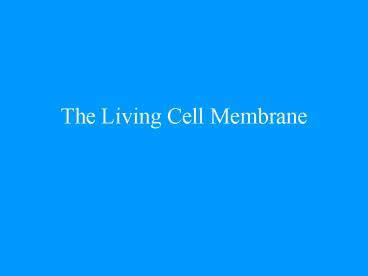The Living Cell Membrane PowerPoint PPT Presentation
1 / 27
Title: The Living Cell Membrane
1
The Living Cell Membrane
2
What is it?
- The cell membrane is a flexible container for the
cells cytoplasm and organelles, - but it is also much more.
- The cell membrane is a semi permeable barrier
which separates the cells cytoplasm and
organelles from the external environment.
3
Semi Permeable?
- A semi permeable membrane is a barrier which
allows only certain molecules to pass through it. - This way the cell membrane can allow certain
molecules to enter the cell while keeping others
out.
4
External Environment Cell
Interior
5
Why is the cell membrane necessary?
- Cells need to both taken in food, or in plants
the materials to make food, and get rid of waste
products. - To avoid absorbing material which would be
harmful or useless to the cell, or losing
material which the cell must retain.
6
What is the Cell Membrane made of?
- The cell membrane is made of many many
phospholipids - The membrane also contains different kinds of
proteins between the phospholipids.
7
How is this Phospholipid Membrane Made?
- The membrane has two layers each composed of
Phospholipids. - The hydrophilic (water loving) heads of each
layer point outwards. - The hydrophobic (water fearing) tails point
inwards.
8
(No Transcript)
9
Where Do The Proteins Fit In?
- The cell membrane has a number of different types
of proteins embedded in it. - Glycoproteins
- Gatekeeper (Porin) Proteins
- Receptor Proteins
- Transport Proteins
10
Glycoproteins
- Glycoproteins carry special sugar molecules which
help identify the cell to the immune system. - Glycoproteins differ between species and
individuals in the same species. (Type A and Type
B blood for example.)
11
(No Transcript)
12
Gatekeeper (Porin) Proteins
- Gatekeeper proteins can open or close to allow or
prevent molecules from entering or leaving the
cell. - These proteins open channels and allow passive
transport by diffusion.
13
(No Transcript)
14
Receptor Proteins
- Receptor proteins connect with hormones on the
cells outer surface - These proteins can trigger changes in the cell.
15
(No Transcript)
16
Transport Proteins
- Transport proteins move specific molecules into
or out of the cell - Transport proteins require ATP (energy) to
function.
17
(No Transcript)
18
Liposomes
- Liposomes are artificial lipid vesicles.
- Liposomes function like cell membranes, they can
fuse with a cell membrane and deliver its
contents into a cell. - They are used in drug and gene therapy.
19
Diffusion
- Passive Transport
20
- Molecules in a solution or gas move about
randomly - This movement is called Brownian Motion
- This causes particles to move from an area of
high concentration to an area of low
concentration. - Concentration is the number of molecules per unit
of volume - Can you think of examples of diffusion of a gas?
How about a solution?
21
Concentration Gradient
- The difference between in the number of molecules
of a substance between adjoining regions.
22
http//highered.mcgraw-hill.com/sites/0072495855/s
tudent_view0/chapter2/animation__how_diffusion_wor
ks.html
23
Osmosis, what is it?
- Osmosis is the diffusion of water across a
selectively permeable membrane - Osmosis is like other diffusion, water molecules
moves from an area of high concentration to an
area of low concentration.
24
(No Transcript)
25
Types of Solutions
- Isotonic solution a solution where the
concentration of solute is equal inside and
outside the cell. - Hypotonic a solution where the concentration of
solute is lower outside the cell than inside. - Hypertonic a solution where the concentration of
a solute is higher outside the cell than inside.
26
Equilibrium
- Equilibrium is a condition in which all acting
influences are balanced and a stable environment
results. - Molecules continue to move in an equilibrium
environment, but there is no net gain or loss of
molecules.
27
Facilitated Diffusion
- Protein carrier molecules, located on cell
membranes, can help in passive transport. - For example glucose diffuses into cells about a
hundred times faster than other similar sugars. - Carrier proteins must be specialized to aid the
diffusion of glucose molecules, but not other
sugars.

